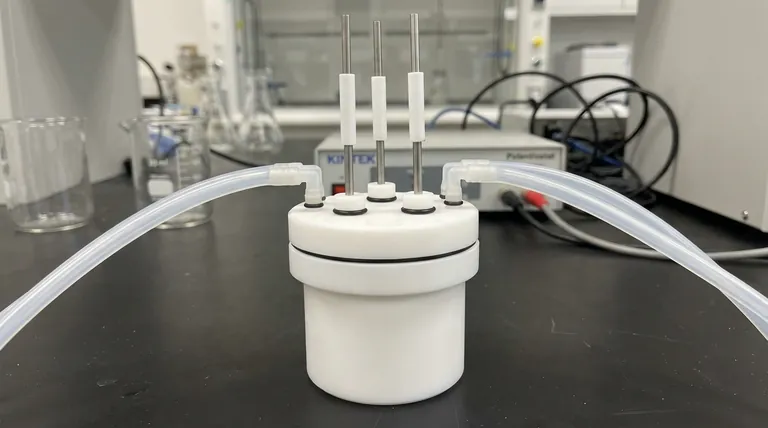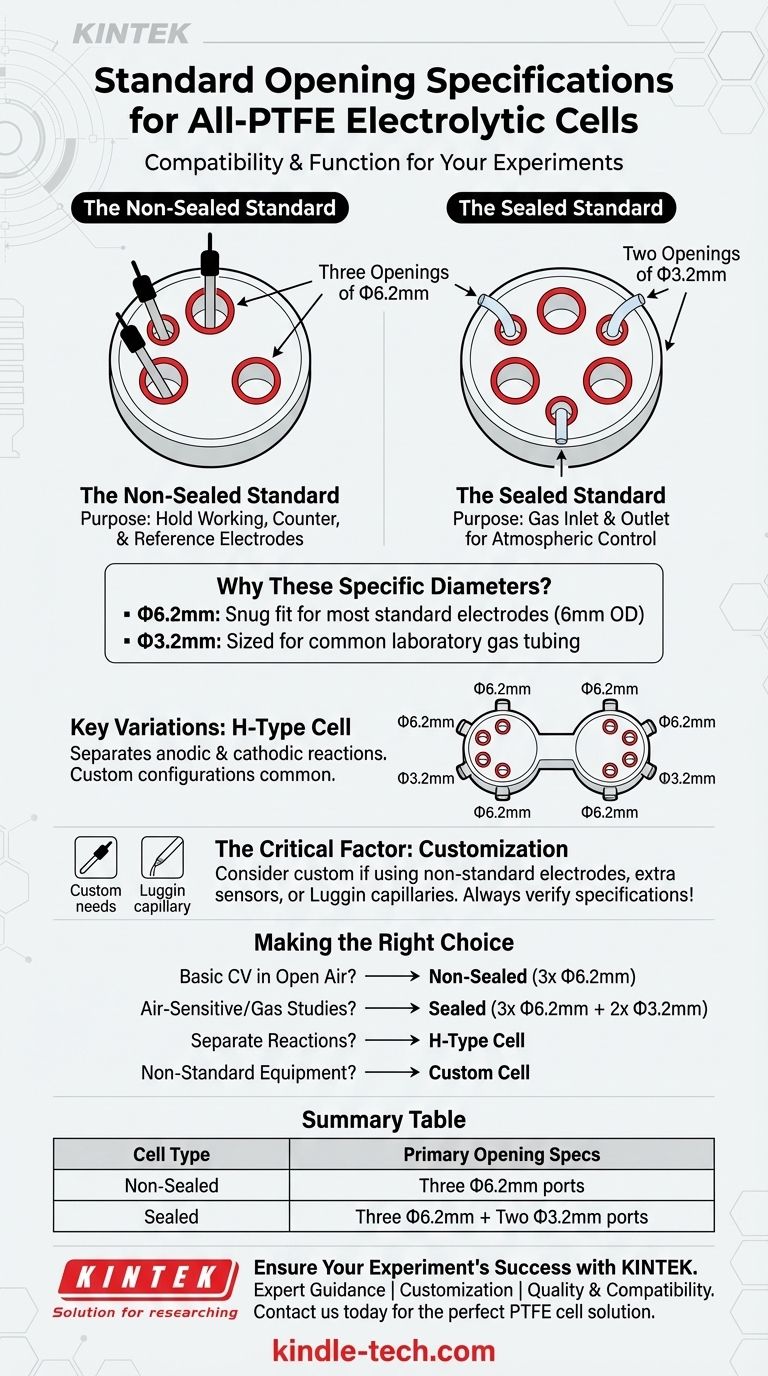For all-PTFE electrolytic cells, the standard opening specification depends directly on whether the cell is a sealed or non-sealed design. The most common non-sealed configuration features three openings of Φ6.2mm. For sealed applications requiring atmospheric control, the standard is three openings of Φ6.2mm and two smaller openings of Φ3.2mm.
The core principle behind these standards is not arbitrary; it's about compatibility. The larger Φ6.2mm ports are designed to accommodate standard electrochemical electrodes, while the smaller Φ3.2mm ports are for gas inlet and outlet tubing.

Deconstructing the Standard Configurations
Understanding the purpose behind each opening is key to selecting the correct cell for your experimental needs. The two primary standards serve distinct functions.
The Non-Sealed Standard: Three Openings
The most basic and common setup is a non-sealed cell with three identical ports, each with a diameter of 6.2mm.
This configuration is designed to hold the three essential electrodes for most electrochemical experiments: the working electrode, the counter electrode, and the reference electrode.
The Sealed Standard: Five Openings
For experiments that are sensitive to air or require a controlled gas environment, a sealed cell is necessary.
The standard for these cells includes the same three Φ6.2mm ports for electrodes, plus two smaller Φ3.2mm ports. These smaller ports are specifically designed for gas lines, allowing you to purge the cell with an inert gas (like nitrogen or argon) or study gas evolution/consumption.
Why These Specific Diameters?
The choice of Φ6.2mm is a practical industry standard. It provides a snug fit for most commercially available electrodes, which typically have an outer diameter of 6mm.
Similarly, the Φ3.2mm ports are sized to fit common laboratory tubing used for gas flow, ensuring a secure connection for purging or analysis.
Understanding Key Variations
While the three- and five-port cells are the most common, specialized experiments often require different designs, such as the H-type cell.
What is an H-Type Cell?
An H-type cell consists of two separate chambers connected by a membrane or frit. Its purpose is to separate the reactions occurring at the anode and cathode, preventing the products of one from interfering with the other.
A Typical H-Type Configuration
Due to its two-chamber design, a sealed H-type cell has more openings. A representative configuration might have one chamber with two 6.2mm electrode ports and two 3.2mm gas ports, and the second chamber with one 6.2mm electrode port and two 3.2mm gas ports.
The Critical Factor: Customization
It is crucial to recognize that "standard" does not mean "universal." The references consistently highlight that aperture configurations can be customized.
When to Deviate from the Standard
You should consider a custom configuration if your setup involves non-standard electrode diameters, requires extra ports for sensors (like a thermometer or pH probe), or needs a specific port for a Luggin capillary to minimize iR drop.
The Importance of Verification
Never assume a standard cell will fit your equipment. Always verify the specifications with the manufacturer before purchasing. Providing the diameters of your specific electrodes and probes will ensure you receive a cell that is immediately usable for your experiment.
Making the Right Choice for Your Experiment
Your experimental goal is the ultimate guide to selecting the correct cell configuration.
- If your primary focus is basic cyclic voltammetry in an open-air environment: The standard non-sealed cell with three Φ6.2mm ports is likely sufficient.
- If your primary focus is air-sensitive research or gas evolution studies: The sealed cell with three Φ6.2mm and two Φ3.2mm ports is the necessary starting point.
- If your primary focus is separating anodic and cathodic processes: You must look beyond simple beaker cells to an H-type cell configuration.
- If you are using non-standard equipment or specialized probes: You will need to request a custom-drilled cell tailored to your specific hardware dimensions.
Ultimately, matching the cell's specifications to your unique experimental requirements is the only standard that truly matters.
Summary Table:
| Cell Type | Primary Opening Specs | Purpose |
|---|---|---|
| Non-Sealed | Three Φ6.2mm ports | Hold standard working, counter, and reference electrodes |
| Sealed | Three Φ6.2mm ports + Two Φ3.2mm ports | Electrode placement plus gas inlet/outlet for atmospheric control |
Ensure Your Experiment's Success with the Right PTFE Cell
Choosing the correct electrolytic cell is critical for achieving accurate and reproducible results. The standard port configurations are just the starting point. Whether you need a standard sealed cell for air-sensitive studies or a fully customized H-type cell for specialized applications, KINTEK is here to help.
Why choose KINTEK for your lab equipment needs?
-
Expert Guidance: Our team understands electrochemical setups and can help you select or design the perfect cell for your specific electrodes and experimental conditions.
-
Customization: We specialize in tailoring cell configurations—including port sizes, numbers, and layouts—to fit non-standard electrodes, probes, and Luggin capillaries.
-
Quality & Compatibility: Our all-PTFE cells are manufactured to precise specifications, ensuring compatibility with your existing lab equipment and long-term durability.
Don't let an ill-fitting cell compromise your research.
Contact KINTEK today to discuss your requirements. Let us provide you with a electrolytic cell solution that fits your experiment perfectly.
Visual Guide

Related Products
- PTFE Electrolytic Cell Electrochemical Cell Corrosion-Resistant Sealed and Non-Sealed
- Electrolytic Electrochemical Cell with Five-Port
- Double Layer Five-Port Water Bath Electrolytic Electrochemical Cell
- Electrolytic Electrochemical Cell for Coating Evaluation
- Thin-Layer Spectral Electrolysis Electrochemical Cell
People Also Ask
- How should an all-PTFE electrolytic cell be handled to prevent mechanical damage? Protect Your Investment and Data Integrity
- Are there any chemical substances that should be avoided with an all-PTFE electrolytic cell? Know the Critical Limits for Your Lab
- What materials are the coating evaluation electrolytic cell and its lid made of? Ensuring Accurate Electrochemical Testing
- What materials are used for the body of a super-sealed electrolytic cell and what are their properties? Select the Right Material for Your Experiment
- What is the proper method for cleaning the surface of an all-PTFE electrolytic cell? Ensure Accurate Results with a Pristine Surface



















